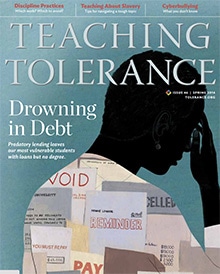Teaching Tolerance magazine examines impact of student loan practices on most vulnerable college students
Recent policy changes affecting student loans, coupled with the skyrocketing cost of attending college, are creating financial traps for the most vulnerable students and their families, leaving many students drowning in unmanageable debt even if they fail to get a degree, according to the latest issue of Teaching Tolerance magazine, released today by the Southern Poverty Law Center.
Recent policy changes affecting student loans, coupled with the skyrocketing cost of attending college, are creating financial traps for the most vulnerable students and their families, leaving many students drowning in unmanageable debt even if they fail to get a degree, according to the latest issue of Teaching Tolerance magazine, released today by the Southern Poverty Law Center.
The cover story of the Spring 2014 issue – “Drowning in Debt” – examines the disproportionate impact of student loan debt, and predatory lending practices on students of color, children of immigrants and first-generation college students.
“The rise in the cost of higher education over the past four decades is unprecedented,” said Teaching Tolerance Director Maureen Costello. “With recent shifts in financial aid policies and lending practices that prey on the most vulnerable students, a college degree – and upward mobility – is an increasingly distant goal. Teaching Tolerance offers ways high school counselors and teachers can help disadvantaged students by sharing critical knowledge with them as early as the ninth grade.”
Since 1978, college tuition and fees have ballooned by more than 1,100 percent – a rate that’s four times the rate of inflation. And, last year, total student loan debt exceeded $1.1 trillion, surpassing the country’s combined credit card debt.
This debt burden falls disproportionately on African-American and Latino students, and it’s particularly devastating for students who leave school without obtaining a degree. According to a report by the Center for American Progress and Campus Progress, 81 percent of African-American students and 67 percent of Latino students graduate from college with debt compared to 64 percent of their white peers. The report also notes that 69 percent of African Americans who drop out of school cite their debt burden as a major factor in their decision.
Other articles in this issue of Teaching Tolerance help teachers explore alternatives to harmful disciplinary techniques; teach students about slavery; and expose how kids are using new apps to engage in gender-based cyberbullying. The issue also provides educators with a wide range of anti-bias resources, including the “Why I Teach” section in which a featured teacher shares what motivates her to teach and an “Activity Exchange” featuring teacher-submitted lesson plans for various grade levels.
The Spring 2014 issue of Teaching Tolerance can be read online at www.tolerance.org/magazine/number-46-spring-2014 .
Teaching Tolerance magazine, published three times a year, is the nation’s leading journal serving educators on diversity issues. It is distributed free of charge to more than 410,000 educators nationwide.


